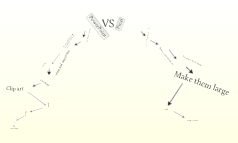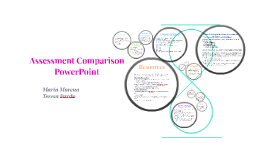Assessment Comparison PowerPoint
Transcript: Scholastic Aptitude Test (SAT) Publisher: Florida Department of Education Publishing year: 2006 Purpose: This test serves as a tool to measure the progress of English Language Learners (ELLs) proficiency in English; thus, ensuring the skills needed in school to achieve at high levels academically. Levels assessed: The CELLA Test has four levels Level A: K-2 Level B: 3-5 Level C: 6-8 Level D: 9-12 Skills/Competencies Assessed: listening, speaking, reading, and writing Maria Moreno Teresa Pardo Reliability: Four different kinds of reliability coefficients can be used in relation to FCAT – 1.Internal Consistency 2.Test-Retest Reliability 3. Inter-Rater Reliability 4. Reliability of Classifications Only test competence of NGSS, does not assess knowledge passed standards. Validity:Only test competence of NGSS, does not assess knowledge passed standards. To ensure high content validity of FCAT, the Department of Education has implemented the following steps for all of the items included on FCAT – 1. Item specifications were written. 2. Test items were written according to the guidelines provided by the item specifications. 3. The items were pilot tested using randomly selected groups of students at appropriate grade levels, ETC. Florida Comprehensive Assessment Test 2.0 (FCAT) Continuation .. Florida Comprehensive Assessment Test 2.0 (FCAT) Publisher: Florida Center for Reading Research (FCRR) and Florida Department of Education Publishing Year: 1985 Purpose:The Florida Assessments for Instruction in Reading (FAIR) is a screening, diagnostic and ongoing progress monitoring assessment that measures Phonemic awareness, phonics, fluency, vocabulary and comprehension. In grades K-2 the assessment is administered individually to students. In grades 3-12 the assessments are computer-adaptive and delivered on Internet-connected computers. Levels Assessed:Kindergarten-12th Skills/competencies assessed: Reading comprehension, listening comprehension, vocabulary, fluency, orthographic processing, spelling knowledge Administration:Three times per year, in August, November, and March Reliability: about .90 across all grades Validity: negative predictive power of the test is 85%, 85% of the not-at-risk students would end up not-at-risk. Florida Standard Assessment (FSA) Resources Florida Assessments for Instruction in Reading (FAIR) Comprehensive English Language Learning Assessment (CELLA) Publisher: College Board Publishing year: 1956 Purpose: Passing the test will grant student college credits along with high school credits Levels/Grades: 9th – 12th Skills/ Competencies: College-level curricula Administration: 1st two weeks of May Reliability: yes; test is pretested before given out Validity: Content-related evidence of validity Publisher: Publisher: American Institute for Research and Data Recognition, Corp. & Florida Department of Education Publisher Year: 2014 Purpose: To measure how well students in third through eleventh grades understand Florida’s Common Core-based standards Levels/Grades: 3rd - 11th Grade (depending on subject) Skills/Competencies Assessed: Math, reading and writing (reading and writing are combined as English/LA) Students meeting the required standards for English/LA in grades 3-8, mathematics and EOC. Requirements: Algebra 1, 2 and geometry. Creating higher order thinking skills by graphing, reading and integrating. Administration: March – April Reliability: Not yet available Validity: Not yet available Administration:Kindergarten students are administered all four sections of the test, one-on-one with a teacher. Students in grades 1-12 take the speaking section of the test one-on-one with a teacher; the listening, reading, and writing sections are administered in a group setting. The test is administered February – April. Reliability: Not provided Validity: Test does not compare with other measures, for example the home language survey Publisher: ACT, Incorporated Publishing Year: 1959 Purpose: The test is designed to assess academic readiness for college, scores are used by many colleges and universities for undergraduate admissions. Levels Assessed: 11th and 12th grade Skills/Competencies Assessed: English, mathematics, reading, science and writing. Administration: The SAT is a paper-based standardized test, administered 6 times a year, on select dates from September through June Reliability: inconclusive Validity: inconclusive Although for both, there is much research and many arguments questioning the reliability and validity of the ACT. Research leans towards the test being invalid and unreliable. American Institute of Research (Air) Publisher: Pearson Education Publisher Year: 1926 Purpose: The SAT series is used to measure academic knowledge. Levels Assessed: K–2nd (in Miami-Dade) Skills/Competencies Assessed: Reading comprehension, mathematics problem-solving, language, spelling, listening comprehension, science, social science Administration: March – April Reliability: The test has a

















